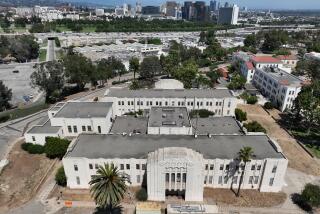Residents Question How Warner Center Plan Will Affect Them
William Parker came to the stuffy auditorium at Parkman Junior High School in Woodland Hills Wednesday in search of answers. Specifically, he wanted to know if what he heard about building elevated streets in Warner Center--including one right outside his townhouse--was true.
It was, and after listening to Los Angeles planning officials explain various maps and charts, a disappointed Parker shook his head and said: “We’re going to be like New York City, where you can’t park, you can’t walk, you can’t travel.”
Parker was among about 100 residents who attended a city-sponsored workshop, looking for answers about the city’s plans for Warner Center, which is expected to nearly double in size over the next two decades.
The proposed Warner Center Specific Plan--released last month--allows construction of an additional 11.8 million square feet of commercial and residential space over the next 20 years, increasing the center’s size to 26.8 million square feet. That is a reduction from the current limits, which would allow about 35.7 million square feet.
City planners, estimating that $1.3 billion in road improvements would be needed in and around the center to handle increased traffic, have called for construction of elevated streets and improved freeway off-ramps to relieve congestion. About half the road improvements would be financed by developers, who would be charged $14,990 for each daily car trip generated by their projects.
The elevated streets would carry through traffic on upper levels, eliminating the need for stoplights, while local traffic would move at ground level.
Wednesday’s workshop provided an informal opportunity for the public to question city planners in preparation for a public hearing next Wednesday. Testimony from next week’s hearing will be incorporated into a final version of the plan, which will be presented to the Planning Commission.
“This is in order to have people provide testimony that will be meaningful to the city,” said Frank Fielding, chief city planner for the Valley. “We’re not trying to sell anything. We’re here as an information source only.”
During a spirited question and answer session, Fielding repeatedly assured the audience that the plan before them was only a “first cut” and not the final product. “This is our first opportunity to bring something to the public and say, ‘This is what we’ve been doing.’ It’s not a final anything,” he said.
Homeowners’ concerns ranged from new crosswalks to whether traffic from new projects would adversely affect neighborhoods elsewhere in the Valley. Many were worried only about how the plan would affect their immediate neighborhoods.
Susan Hill and Renee Natali came because they thought their homes would be bulldozed to make way for an elevated roadway along Topanga Canyon Boulevard. After being assured by planning officials that their homes were not in danger, Hill said, “As far as I’m concerned, we can leave.”
All Jana Nagy sought was assurance that the park where her 2-year-old daughter plays will be spared from development and that traffic will not increase to levels that would make the park inaccessible. “My main concern is that they plan well enough so they accommodate the pedestrians,” she said.
Councilwoman Joy Picus, homeowners, developers and even some city planners have agreed that the current plan is inadequate, but for different reasons. Picus and the homeowners complained that the elevated roadways would destroy the suburban nature of streets around the center.
Gordon Murley, vice president of the Woodland Hills Homeowners Assn., said the city’s traffic plans are unreasonable and would only create even larger “rolling parking lots.”
“It doesn’t work now at the level of traffic that exists,” he said. “So the only way it will ever work is if they never add another car trip to the center. Common sense is not something that seems to work in the atmosphere of City Hall.”
Developers, too, have complained about the road improvements, but largely because they do not want to pay for them. The Woodland Hills Chamber of Commerce earlier this week claimed that if the plan is adopted, developers would refuse to build in Warner Center--now one of the Valley’s premier business addresses--because it would become too expensive.
Both homeowners and developers faulted the city for not taking into account the effects of future mass transit systems, but Fielding said they probably will be added to the final version. Mass transit was left out of the current plan because city officials did not know if and when proposed rail lines would reach Warner Center, and they needed to specify interim measures to control traffic, Fielding said.
The public hearing will be held next Wednesday at 5:30 p.m. at Parkman Junior High.
More to Read
Sign up for Essential California
The most important California stories and recommendations in your inbox every morning.
You may occasionally receive promotional content from the Los Angeles Times.









